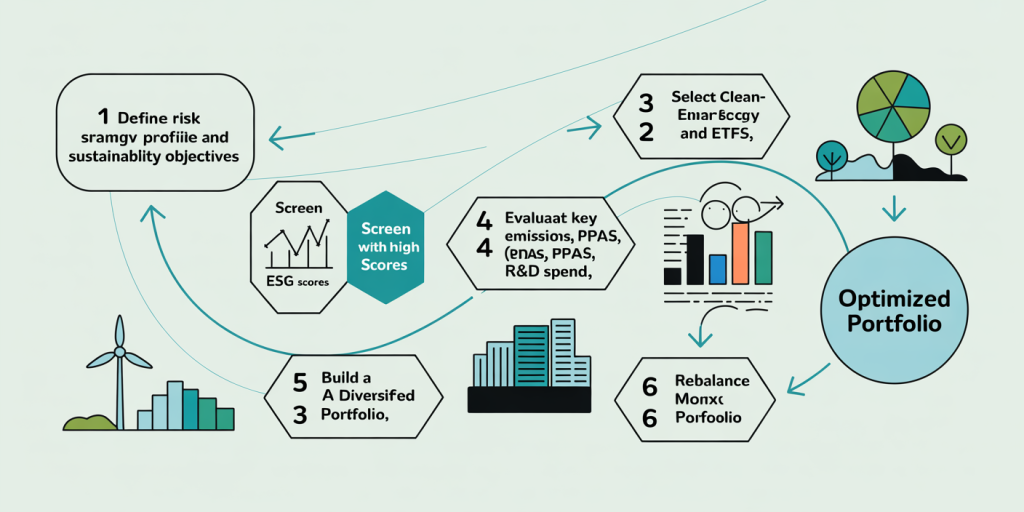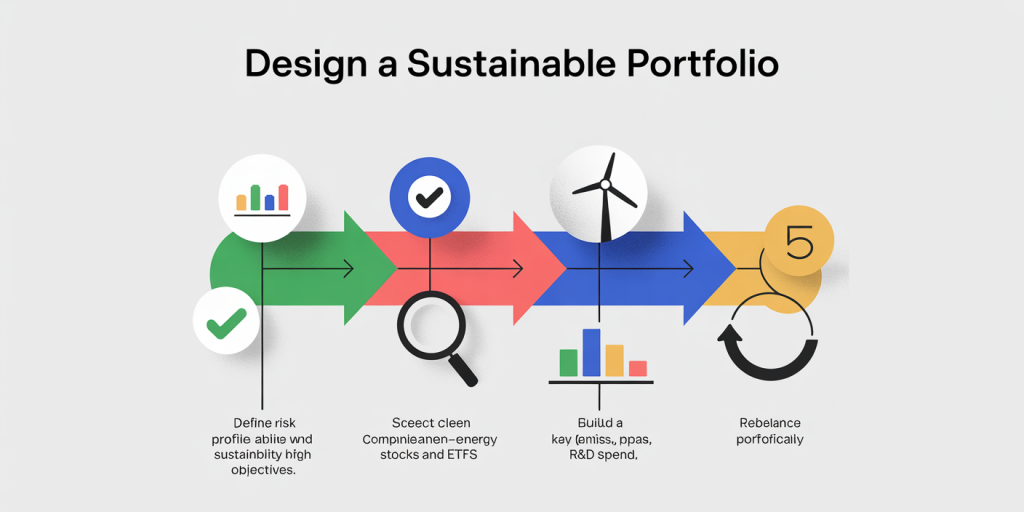Investing in Green Energy: ESG Stocks, ETFs, and the Future of Sustainability
Anúncios
Introduction
In today’s landscape, the global energy transition and growing environmental awareness have driven increasing investor interest in clean energy and sustainability-linked assets. Innovative companies in renewables—such as solar, wind, green hydrogen, and biofuels—not only offer growth potential above traditional markets but also help mitigate risks tied to climate change and ever-stricter environmental regulations. Moreover, the concept of ESG (Environmental, Social, and Governance) has become a key lens for evaluating not just financial returns but a company’s broader impact. In this article, you’ll explore green-energy ESG stocks, specialized ETFs, core evaluation metrics, inherent risks, regulatory frameworks, emerging trends, and a step-by-step guide to building a sustainability-focused portfolio. Over approximately 3,000 words, you’ll see why green-energy investing can deliver diversification, value alignment, and compelling medium- to long-term returns.
Why Invest in Green Energy?
Several converging factors make clean energy one of the most promising sectors for investors:
Anúncios
- Rising demand
Governments and corporations worldwide are setting aggressive carbon-reduction targets and pouring billions into renewables. For example, the European Union aims to cut emissions by 55% by 2030, requiring massive deployment of clean capacity. - Economies of scale
Over the past decade, the cost of solar and wind power has plunged, often undercutting fossil fuels. That cost advantage attracts both public and private capital, expanding markets for panel manufacturers, turbine builders, and project developers. - Technological innovation
Advances in storage—lithium-ion batteries, flow batteries, green hydrogen—boost the reliability and appeal of intermittent renewables. Both startups and tech giants are driving these breakthroughs, creating diversified investment opportunities. - Government incentives
Subsidies, tax credits, and stimulus packages lower capital costs for green projects. The U.S. Inflation Reduction Act, for instance, allocates trillions for clean-energy subsidies, igniting a wave of investment. - Impact-driven demand
Institutional and retail investors increasingly seek financial returns aligned with sustainable practices, fueling a proliferation of ESG-branded funds and products.
Together, these drivers create a fertile environment for risk-adjusted returns and portfolio resilience.

Understanding ESG and Its Importance
ESG stands for Environmental, Social, and Governance—three dimensions for assessing corporate sustainability:
- Environmental: Greenhouse-gas emissions, waste management, water use, pollution, biodiversity.
- Social: Labor practices, community relations, diversity, human rights, product safety.
- Governance: Board structure, transparency, compliance, executive pay, anti-corruption policies.
Why ESG Matters
- Risk mitigation
High-ESG companies tend to avoid fines, lawsuits, and scandals, preserving shareholder value. - Access to capital
Lenders and asset managers favor ESG-strong firms with better financing terms. - Consumer preference
Customers and partners reward sustainable brands, boosting revenue and reputational capital. - Indicator of long-term focus
ESG commitment signals durable, forward-looking management and operational resilience.
ESG Evaluation
Agencies like MSCI ESG, Sustainalytics, and Bloomberg ESG assign ratings based on dozens of metrics. In clean energy, look for firms with strong energy-efficiency records, storage innovations, and cradle-to-grave sustainability policies. Always cross-check multiple rating sources before investing.
Clean Energy Asset Classes
To capture the energy transition, consider these asset classes:
- Individual equities
- Turbine manufacturers (Vestas, Siemens Gamesa)
- Renewable utilities (NextEra Energy, Iberdrola)
- Battery innovators (QuantumScape, Northvolt)
- Green bonds
Debt financing explicitly for environmental projects, usually ICMA-certified. - ESG-focused ETFs & mutual funds
- ETFs: iShares Global Clean Energy (ICLN), Invesco Solar (TAN), First Trust NASDAQ Clean Edge Green Energy (QCLN).
- Active funds: ESG-themed mutual funds seeking top sustainability performers.
- Infrastructure funds
Access large-scale solar farms, offshore wind parks, and hydrogen facilities—ideal for long-term investors. - Green private equity & VC
Direct stakes in early-stage clean-tech startups. High upside, higher risk, lower liquidity. - Energy infrastructure REITs
Real estate trusts owning solar and wind assets, offering stable lease-based cash flows.
Mixing these classes balances return potential, volatility, and liquidity in a green portfolio.
Top ESG Clean Energy Stocks
Key companies balancing growth and sustainability:
- NextEra Energy (NEE)
- World’s largest wind and solar generator
- MSCI ESG rating: AAA, with an expanding project pipeline
- Ørsted (ORSTED)
- Global offshore-wind leader
- Net-zero emissions target by 2040
- Enphase Energy (ENPH)
- Residential solar microinverters
- Revenue growth paired with gross margins above 40%
- Vestas Wind Systems (VWS)
- Pioneering onshore/offshore turbines
- Extensive maintenance network, long-term contracts
- First Solar (FSLR)
- Thin-film solar panels excel in high-heat environments
- U.S. local-content alignment drives demand
- Brookfield Renewable Partners (BEP)
- Hydro, wind, and solar across multiple geographies
- Business model built on long-term power purchase agreements
Evaluate P/E, P/B, free cash flow, project maturity, leverage, and confirm ESG scores from at least two providers before buying.
Clean Energy Specialized ETFs
ETFs provide instant diversification at low entry cost:
- iShares Global Clean Energy ETF (ICLN)
- Tracks the S&P Global Clean Energy Index (≈30 stocks)
- Expense ratio: 0.42%
- Invesco Solar ETF (TAN)
- Solar-focused, high volatility, sector concentration
- First Trust NASDAQ Clean Edge Green Energy (QCLN)
- Mix of clean energy and storage firms
- Fee: 0.60%
- SPDR S&P Kensho Clean Power ETF (CNRG)
- Broad coverage of clean-power generation, storage, distribution
- Lyxor New Energy UCITS ETF (NRJ)
- European-listed, tracks the New Energy index
Compare tracking error, total expense ratio, and average liquidity to find the best fit.

ESG Evaluation and Performance Metrics
Beyond financial ratios, green-energy investing demands specialized metrics:
- CO₂ emissions per MWh
– Carbon intensity measure; renewables approach zero. - % of revenue from sustainable operations
– Depth of green-business focus. - R&D spend ratio
– Innovation pipeline indicator. - Incident frequency rate (IFR)
– Safety record across operations. - Contract renewal rate
– Stability of future cash flows under PPAs. - Geographic diversification
– Spreads regulatory and market risk.
For ETFs, key stats include tracking error, total expense ratio, and bid-ask spread (average daily volume).
Sector Risks and Challenges
Green-energy isn’t without hurdles:
- Regulatory shifts
– Changes in subsidies, feed-in tariffs, or tax credits can hit revenues. - Tech obsolescence
– New storage chemistries or panel materials may disrupt older assets. - Geopolitical concentration
– Reliance on China for panels or Europe for offshore wind exposes policy risks. - Grid integration
– Storage shortfalls and intermittency affect reliability and returns. - High capital intensity
– Large projects need heavy financing, sensitive to interest rates. - Increasing competition
– Margin pressure from new entrants and cost declines.
Rigorous due diligence on PPAs, balance sheets, project sites, and local regulation is essential.

Government Policies and Regulation
Policy frameworks are pivotal for clean-energy success:
- Subsidies & tax credits
– U.S. Investment Tax Credit, European feed-in tariffs. - Competitive auctions
– Drive down project costs with long-term contracts. - Renewable targets
– Paris Agreement and national quotas enforce clean-power mandates. - Environmental standards
– Stricter emissions and water rules accelerate renewables adoption. - Carbon pricing
– Taxes or cap-and-trade schemes penalize fossil fuels. - Grid modernization
– Legislation promoting smart grids and transmission upgrades eases renewables integration.
Stay alert to regulatory updates, agency rulings, and legal decisions affecting project economics.
Future Trends and Innovations
Emerging developments set to reshape the sector:
- Green hydrogen
– Electrolysis from renewables, targeting decarbonization of heavy industry and long-haul transport. - Long-duration storage
– Next-gen batteries, compressed-air systems, and pumped hydro solutions. - Smart demand management
– IoT and AI dynamically balance consumption and generation in real time. - EV expansion & charging
– Electric-vehicle growth boosts clean-power demand and charging network investment. - Floating solar
– Reservoir-mounted panels reduce evaporation and enhance efficiency. - Decentralized finance (DeFi)
– Blockchain-based crowdlending and tokenized green bonds democratize project funding.
Following patents, research papers, and pilot deployments helps you spot cutting-edge investment prospects.
How to Build Your Green Energy Portfolio
A step-by-step roadmap:
- Define risk & horizon
– Short (3–5 years): heavier clean-tech equity weighting.
– Long (10+ years): add green bonds and mature infrastructure. - Allocate by asset class
– 30% individual stocks, 30% ETFs, 20% green bonds, 10% PE/infrastructure, 10% energy REITs. - Geographic diversification
– Spread across U.S., Europe, Asia, and emerging markets to hedge policy risk. - Use ETFs as core
– Start with ICLN, TAN, QCLN; layer in low-carbon bond funds. - Minimize costs
– Compare TERs, FX spreads, custody fees on international platforms or ADRs. - Automate purchases
– Monthly contributions enable dollar-cost averaging. - Track ESG ratings
– Review semiannually; replace laggards with higher-scoring names. - Rebalance regularly
– Every six months or upon >5% drift from targets. - Monitor policy shifts
– Adjust exposure as auctions, credits, or mandates evolve. - Continuously learn
– Attend industry conferences, read IEA reports, and review vendor white papers.
With disciplined research, automation, and ongoing monitoring, you can craft a green-energy portfolio aligned with both financial goals and sustainability values.
Conclusion
Investing in green energy and ESG assets is more than a bet on growth—it’s putting capital behind a low-carbon, socially responsible future. Through individual stocks, ETFs, green bonds, private equity, and energy REITs, you can build a diversified portfolio that balances return and risk, leverages policy support, harnesses innovation, and adapts to shifting demographics. By evaluating emissions intensity, revenue sources, R&D spending, and ESG scores, you’ll make informed decisions. Yet remain vigilant about regulatory changes, technological disruption, and infrastructure limits. A clear strategy, automated investing, disciplined rebalancing, and continuous policy and tech tracking will position you to capture the coming decades’ opportunities in the global energy transition. By investing in green energy today, you pursue strong financial returns while helping create a more sustainable, equitable planet for future generations.
